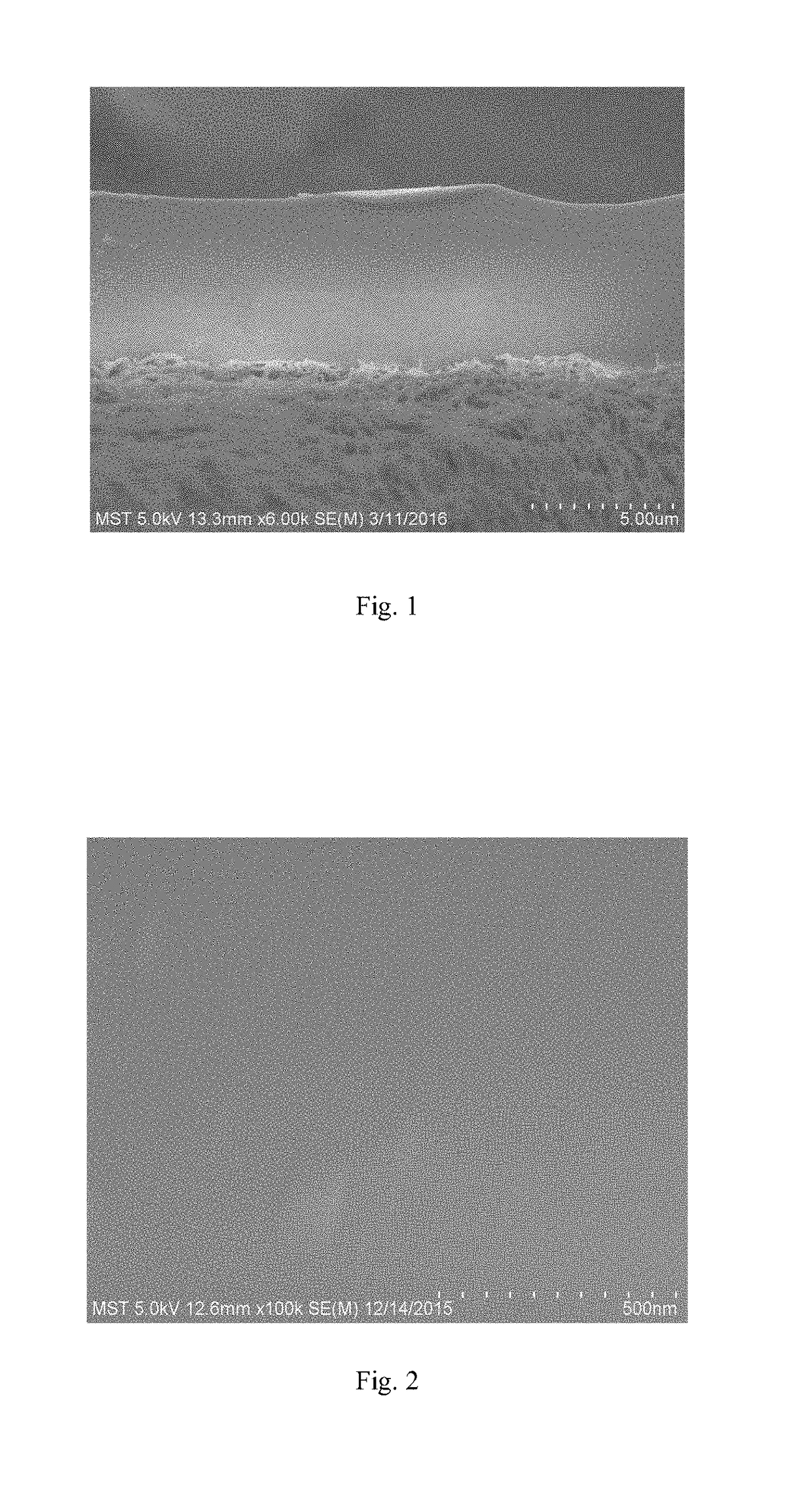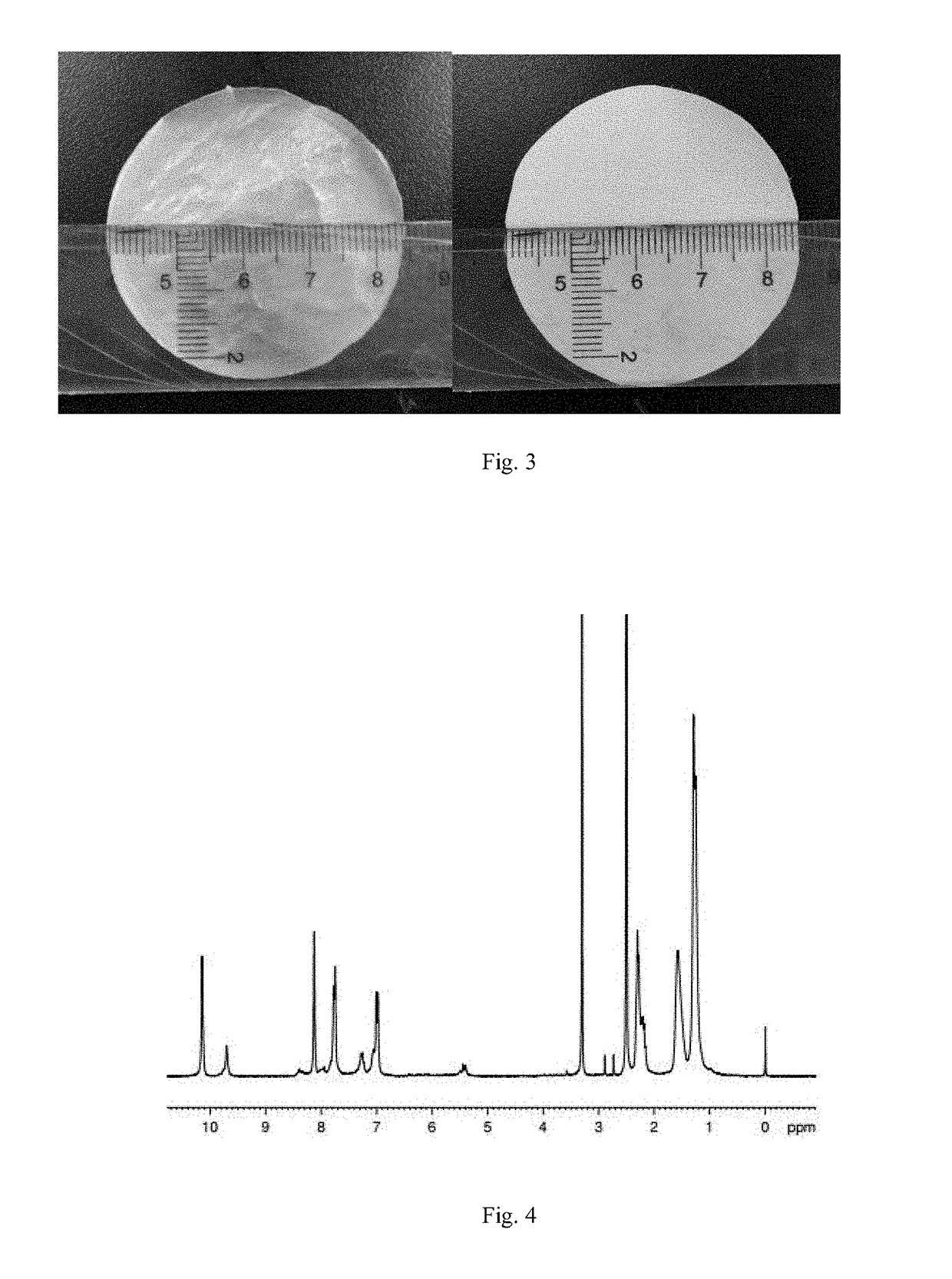A preparation method for triptyl polymer separation membrane
a polymer and separation membrane technology, applied in the field of preparation of polymer separation membranes, can solve the problems of large waste, serious damage to human health, environmental pollution,
- Summary
- Abstract
- Description
- Claims
- Application Information
AI Technical Summary
Benefits of technology
Problems solved by technology
Method used
Image
Examples
embodiment 1
[0038]Take 0.6 g 2,6,14-triamino triptycene, 0.7 g 2,2′-bis(trifluoromethyl)-4,4′-diaminodiphenyl ether and 1.6 g sebacoyl chloride and put them into a 250 ml flask, add 50 ml dimethyl formamide under normal temperature and stir and dissolve them, and then add 1 ml pyridine. Reduce the temperature to −5° C. to react for 5 hours (under protection of nitrogen). Raise to the room temperature when the reaction is completed and then add 150 ml deionized water for precipitation. Filter out the precipitates and wash with methanol for 3-4 times and dry the precipitates in vacuum under 50° C. One of the distinctive features between the method and Patent CN201510883253.2 is that: the composite membrane is dissolved and prepared in aprotic solvent after the prepared polymer goes through washing, purification and drying, which produces composite membrane with higher homogeneity and better separation performance.
Solubility Test:
[0039]Take dried precipitates to conduct solubility test respectivel...
embodiment 2
[0047]Take 0.3 g 2,7,14-triamino triptycene, 0.428 g 1,3-bis(2-trifluoromethyl-4-aminophenoxy)benzene and 0.546 g glutaryl chloride and put them into a 250 ml flask, add 40 ml dimethyl formamide under normal temperature and stir and dissolve them, and then add 1.5 ml triethylamine. Reduce the temperature to 0° C. to react for 10 hours (under protection of nitrogen). Raise to the room temperature when the reaction is completed and then add 100 ml deionized water for precipitation. Filter out the precipitates and wash with methanol for 3-4 times and dry the precipitates in vacuum under 60° C. One of the distinctive features between the method and Patent CN201510883253.2 is that: the composite membrane is dissolved and prepared in aprotic solvent after the prepared polymer goes through washing, purification and drying, which produces composite membrane with higher homogeneity and better separation performance.
Solubility Test:
[0048]Take dried precipitates to conduct solubility test in s...
embodiment 3
[0055]Take 0.45 g 9,10-dimethyl-2,6,14-triamino triptycene, 0.6 g 1,3-bis(2-trifluoromethyl-4-aminophenoxy)benzene and 0.85 g adipoyl chloride and put them into a 250 ml flask, add 45 ml dimethyl formamide under normal temperature and stir and dissolve them, and then add 0.5 ml N,N-diisopropyl ethylamine. Reduce the temperature to 5° C. to react for 12 hours (under protection of nitrogen). Raise to the room temperature when the reaction is completed and then add 120 ml deionized water for precipitation. Filter out the precipitates and wash with methanol for 3-4 times and dry the precipitates in vacuum under 70° C. One of the distinctive features between the method and Patent CN201510883253.2 is that: the composite membrane is dissolved and prepared in aprotic solvent after the prepared polymer goes through washing, purification and drying, which produces composite membrane with higher homogeneity and better separation performance.
Solubility Test:
[0056]Take dried precipitates to cond...
PUM
| Property | Measurement | Unit |
|---|---|---|
| temperature | aaaaa | aaaaa |
| temperature | aaaaa | aaaaa |
| seepage velocity | aaaaa | aaaaa |
Abstract
Description
Claims
Application Information
 Login to View More
Login to View More - R&D
- Intellectual Property
- Life Sciences
- Materials
- Tech Scout
- Unparalleled Data Quality
- Higher Quality Content
- 60% Fewer Hallucinations
Browse by: Latest US Patents, China's latest patents, Technical Efficacy Thesaurus, Application Domain, Technology Topic, Popular Technical Reports.
© 2025 PatSnap. All rights reserved.Legal|Privacy policy|Modern Slavery Act Transparency Statement|Sitemap|About US| Contact US: help@patsnap.com



